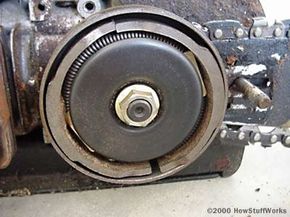The Centrifugal Clutch
The centrifugal clutch is the link between the engine and the chain. The clutch's purpose is to disengage when the engine is idling so that the chain does not move. When the engine speeds up (because the operator has pulled the throttle trigger to begin cutting), the clutch engages so that the chain can cut. You can see the clutch in the following photo:
The clutch consists of three parts:
Advertisement
- An outer drum that turns freely - This drum includes a sprocket that engages the chain. When the drum turns, the chain turns.
- A center shaft attached directly to the engine's crankshaft - If the engine is turning, so is the shaft.
- A pair of cylindrical clutch weights attached to the center shaft, along with a spring that keeps them retracted against the shaft
The center shaft and weights spin as one. If they are spinning slowly enough, the weights are held against the shaft by the spring. If the engine spins fast enough, however, the centrifugal force on the weights overcomes the force being applied by the spring, and the weights are slung outward. They come in contact with the inside of the drum and the drum starts to spin. The drum, weights and center shaft become a single spinning unit because of the friction between the weights and the drum. Once the drum starts turning, so does the chain.
There are several advantages to a centrifugal clutch:
- It is automatic. (In a car with a manual transmission, you need a clutch pedal. A centrifugal clutch doesn't.)
- It slips automatically to avoid stalling the engine. (In a car, the driver must slip the clutch.)
- Once the engine is spinning fast enough, there is no slip in the clutch.
- It lasts forever.
